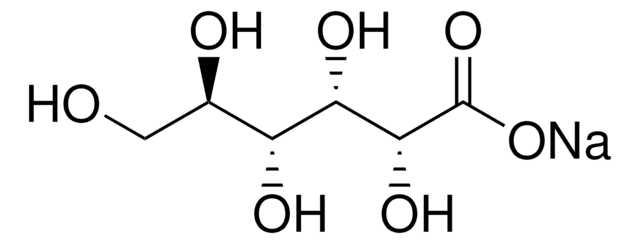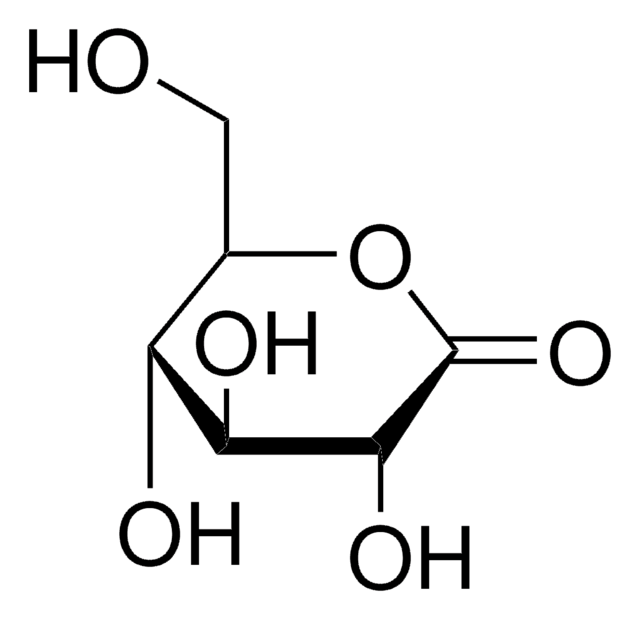G9005
D-Gluconic acid sodium salt
≥99% (HPLC)
동의어(들):
2,3,4,5,6-Pentahydroxycaproic acid sodium salt, D-Gluconate sodium salt, Sodium D-gluconate
로그인조직 및 계약 가격 보기
모든 사진(3)
About This Item
실험식(Hill 표기법):
C6H11NaO7
CAS Number:
Molecular Weight:
218.14
Beilstein:
3919651
EC Number:
MDL number:
UNSPSC 코드:
12352201
PubChem Substance ID:
NACRES:
NA.25
가격 및 재고 정보를 현재 이용할 수 없음
추천 제품
애플리케이션
생화학적/생리학적 작용
D-Gluconic acid is a mild organic acid with non-corrosive, non-odorous, non-volatile and biodegradable property.[4] Enzymatic conversion of D-Glucose results in the final product D-Gluconic acid.[2] Gluconic acid occurs from the oxidation of glucose and is naturally in fruit, honey and wine. When used as a food additive it helps regulate acidity. Sodium salt of D-gluconic acid is a strong chelating agent, chelating the anions of calcium, iron, aluminium, copper, and other heavy metals. It finds wide application in detergent industry for bottle washing, descaling of salt deposits and alkaline derusting. D-Gluconic acid usage as an additive in cement, gives strength and water resistance.[4]
기타 정보
To gain a comprehensive understanding of our extensive range of Monosaccharides for your research, we encourage you to visit our Carbohydrates Category page.
Storage Class Code
11 - Combustible Solids
WGK
WGK 1
Flash Point (°F)
Not applicable
Flash Point (°C)
Not applicable
개인 보호 장비
Eyeshields, Gloves, type N95 (US)
이미 열람한 고객
Gluconic acid: Properties, applications and microbial production.
Ramachandran S, et al.
Food Technology and Biotechnology, 44(2), 185-195 (2006)
Serratia marcescens quinoprotein glucose dehydrogenase activity mediates medium acidification and inhibition of prodigiosin production by glucose.
Fender JE, et al.
Applied and Environmental Microbiology, AEM-01778 (2012)
Phenotyping sensory nerve endings in vitro in the mouse
Zimmermann K, et al.
Nature Protocols, 4(2), 174-196 (2009)
Evaluation of intracellular pH regulation and alkalosis defense mechanisms in preimplantation embryos
Dagilgan S, et al.
Theriogenology, 83(6), 1075-1084 (2015)
Yasaman Barekatain et al.
Communications biology, 3(1), 328-328 (2020-06-27)
Magnetic resonance (MR) spectroscopy has potential to non-invasively detect metabolites of diagnostic significance for precision oncology. Yet, many metabolites have similar chemical shifts, yielding highly convoluted 1H spectra of intact biological material and limiting diagnostic utility. Here, we show that
자사의 과학자팀은 생명 과학, 재료 과학, 화학 합성, 크로마토그래피, 분석 및 기타 많은 영역을 포함한 모든 과학 분야에 경험이 있습니다..
고객지원팀으로 연락바랍니다.







